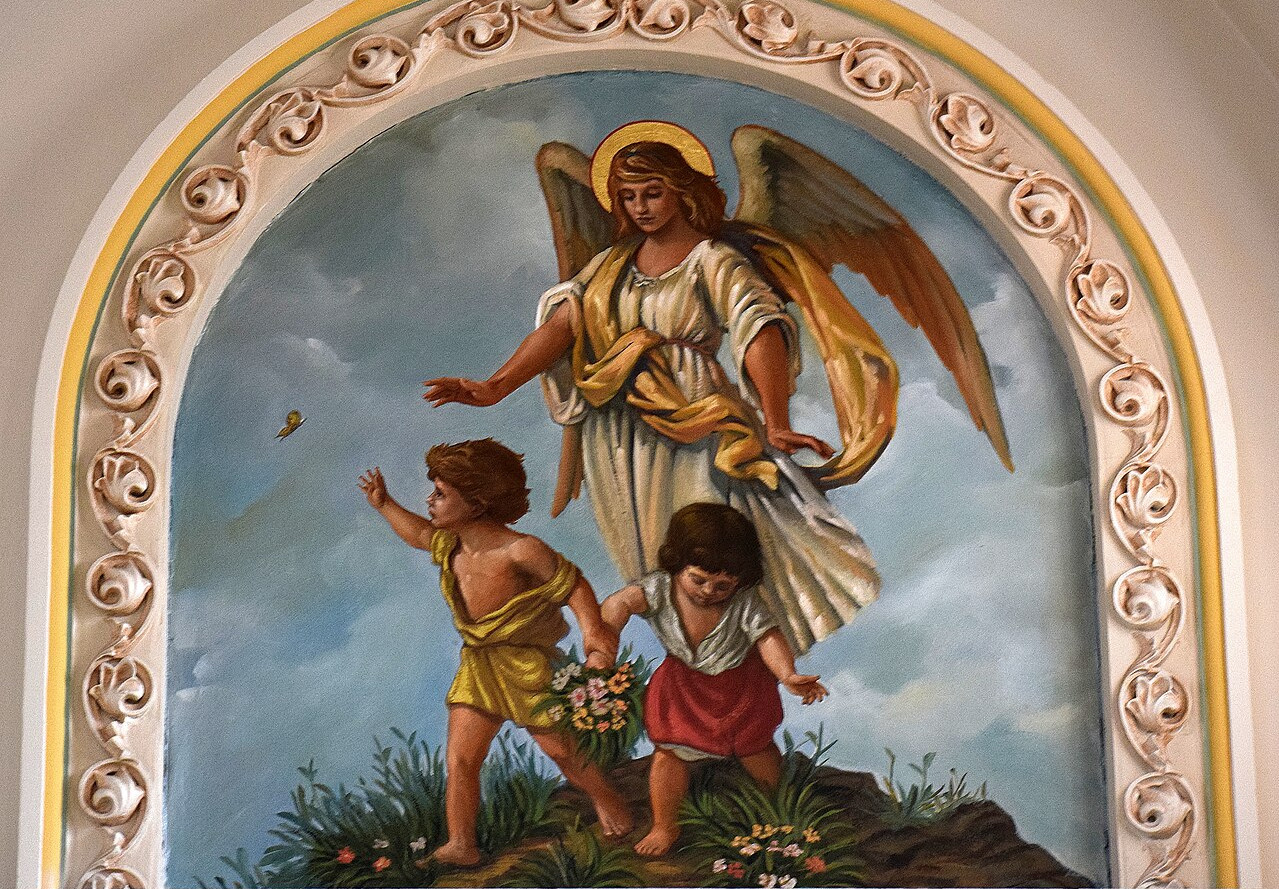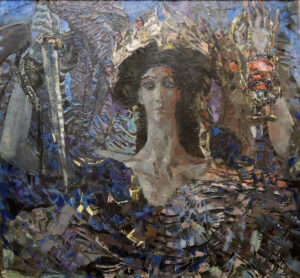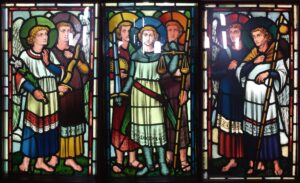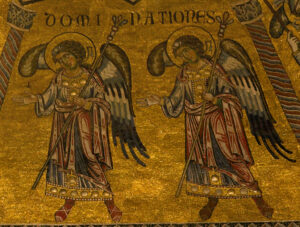Featured image: Guardian Angel, fresco at Saint Mary Catholic Church (Tiffin, Ohio). Nheyob, CC BY-SA 4.0, via Wikimedia Commons.
Key Takeaways
- Ancient Roots: The concept of guardian angels has roots in ancient religions, where supernatural beings served as protectors and guides.
- Jewish and Christian Evolution: Jewish angelology influenced early Christian beliefs, shaping the idea of personal guardian angels.
- Biblical Foundations: Key Bible verses suggest angels as protectors, laying the foundation for the belief in guardian angels within Christianity.
- Theological Development: Early theologians like St. Jerome and St. Thomas Aquinas formalized the role of guardian angels as personal protectors and guides.
- Art and Literature: Christian art and literature have popularized the image of guardian angels, reinforcing their role as compassionate protectors.
- Cross-Cultural Parallels: Similar protective figures appear in other religions, reflecting a universal human desire for guidance and security.
- Psychological Insight: Belief in guardian angels can serve as a comforting psychological mechanism, symbolizing inner strength and resilience.
- Cultural Values: Guardian angels embody social ideals of compassion, protection, and personal dignity across cultures.
Across cultures and centuries, few spiritual concepts offer as much comfort as the idea of a guardian angel—a benevolent being assigned to protect and guide each of us. In Christian tradition, guardian angels are seen as divine protectors who accompany individuals from birth to death, guiding them through life’s challenges and shielding them from unseen dangers. This notion of a personal, invisible protector provides reassurance, especially during difficult times, by suggesting that no one is ever truly alone.
But where did this idea originate? Are guardian angels a uniquely Christian concept, or do they have roots that reach even further back? To understand the significance of guardian angels within Christian mythology, we must look beyond popular images of winged beings hovering protectively. We need to trace their origins in ancient religious traditions, examine their development through centuries of Christian theology, and consider the ways they’ve been reimagined over time. From their early counterparts in pre-Christian mythologies to their formalization in medieval Christian doctrine, guardian angels reveal a deep-seated human yearning for protection, guidance, and connection to the divine.
Table of Contents
Ancient Origins of Angelic Beings in Religious Texts and Mythology
The idea of supernatural beings who act as protectors and guides is far older than Christianity. From ancient Mesopotamian gods to Roman household spirits, many cultures imagined divine or semi-divine entities watching over individuals and communities. These early beliefs laid the foundation for the later development of guardian angels in Christianity.
Pre-Christian Influences: Guardians and Guides in Ancient Religions
In Mesopotamian religion, for example, protective spirits like the shedu and lamassu—often depicted as human-headed, winged bulls or lions—were believed to guard temples, palaces, and cities. These beings symbolized powerful, protective forces warding off evil.
In ancient Egypt, a personal protective spirit known as the ka was thought to accompany each individual from birth, serving as a divine presence that safeguarded the person in life and into the afterlife. Although the ka is not precisely a “guardian angel” in the Christian sense, it reflects an early belief in a personal protector tied to one’s fate.
Similarly, in Zoroastrianism, we find the concept of the fravashi—spiritual guardians associated with each person, as well as with communities, natural elements, and the entire cosmos. Fravashis were believed to offer protection and guidance, helping individuals in moral and spiritual struggles. This Zoroastrian idea influenced later Jewish and Christian beliefs, contributing to the development of angelic figures as personal guardians.

Angels in Judaism: Divine Messengers and Protectors
In the Hebrew Bible, angels serve as intermediaries between God and humanity, delivering messages and occasionally intervening to protect the faithful. The Hebrew word for angel, mal’akh, means “messenger.” Angels appear in stories such as the protection of Lot and his family in the Book of Genesis, illustrating their role as agents of divine care.
By the Second Temple period (roughly 500 BC–70 AD), Jewish beliefs about angels had become more complex, partly due to Persian and Hellenistic influences. Jewish texts from this time, such as the Book of Daniel and apocryphal works like the Book of Enoch, describe a structured angelic hierarchy. In Daniel, the archangel Michael is portrayed as the protector of Israel, suggesting that angels could be assigned to watch over particular groups or individuals.
The Book of Enoch elaborates on angelology, describing ranks and roles of angels, including watchers and protectors, and even a group of fallen angels. This structured hierarchy laid the groundwork for later Christian ideas of guardian angels specifically assigned to protect individuals.
Influence on Christianity: From Jewish to Christian Angelology
Early Christianity adopted many beliefs about angels from Judaism, while also introducing new ideas. In the New Testament, angels are seen as messengers and protectors. For example, in Luke’s Gospel, the angel Gabriel announces the birth of Jesus, while in Matthew’s Gospel, an angel warns Joseph to flee to Egypt to protect the infant Jesus from Herod’s massacre.
One of the most significant New Testament references supporting the idea of personal guardian angels is in Matthew 18:10, where Jesus says,
See that you do not despise one of these little ones. For I tell you that in heaven their angels always see the face of my Father who is in heaven.
Although somewhat ambiguous, this passage has been widely interpreted as suggesting that each individual has a unique angel assigned to watch over them.
As Christianity spread throughout the Roman Empire, it absorbed local beliefs about spiritual protectors. For instance, in Greco-Roman thought, a daemon was often considered a benevolent guiding spirit assigned to individuals or families. Early Christians distinguished between benevolent angels who serve God and malevolent demons, shaping the doctrine of guardian angels as good, protective beings.
By the end of the first century, a more formal angelic hierarchy began to take shape within Christianity, incorporating elements from Jewish, Persian, and Greco-Roman traditions. This synthesis of ideas led to a distinct category of angels whose purpose was to offer personal protection and guidance.
Guardian Angels in Christian Scripture
The concept of guardian angels in Christianity is often associated with specific passages in the Bible that suggest angelic protectors are assigned to individuals. Although the Bible does not explicitly use the term “guardian angel,” several verses in both the Old and New Testaments imply that angels protect, guide, and even intercede on behalf of humans. These passages have inspired centuries of theological reflection and popular devotion.
Biblical Basis for Guardian Angels: Key Old Testament Verses
In Psalm 91:11-12, it states:
For he will command his angels concerning you to guard you in all your ways; on their hands they will bear you up, lest you strike your foot against a stone.
This verse depicts angels as protectors who intervene to prevent harm, especially for those who trust in God. Although it doesn’t refer to a “guardian angel” specifically, it has been interpreted as implying angelic protection for believers.
Another notable reference is found in the Book of Tobit, an apocryphal text included in the Catholic and Orthodox canons. In this story, the archangel Raphael is sent by God to protect and guide Tobias on a perilous journey. Raphael’s role as a guide and healer has influenced Christian ideas of personal angels assigned to individuals.
New Testament Developments: Personal Guardian Angels in the Gospels and Acts
The New Testament offers additional support for the idea of guardian angels. As mentioned above, in Matthew 18:10, Jesus speaks about “little ones,” implying they have angels who are “always before the face of [His] Father in heaven.” Many theologians interpret this as evidence that individuals, especially the vulnerable, have specific angels assigned to protect them.
Another reference appears in Acts 12:5–15, in the story of Peter’s miraculous escape from prison. After an angel frees Peter, the believers, upon hearing that Peter is at the door, dismiss the servant girl’s claim, saying, “It must be his angel.” This response suggests that early Christians may have believed individuals have personal angels who sometimes appear in their likeness.
Angels as Intermediaries and Protectors: Theological Interpretations
These biblical references have inspired extensive theological interpretation. The Church Fathers—including St. Jerome, St. Basil the Great, and St. Augustine—argued for the existence of personal guardian angels based on passages like Matthew 18:10. St. Jerome, for instance, claimed that each person has an angel assigned to them, advocating for the idea of individual protection and intercession.
St. Basil and St. Thomas Aquinas further developed the doctrine of guardian angels, emphasizing their protective role against both physical and spiritual dangers. Aquinas argued that angels are present to guide individuals toward moral choices, intercede with God, and shield them from harm.
Although the Bible doesn’t define a doctrine of guardian angels, scriptural passages and interpretations by early theologians shaped a tradition of belief in angels as personal protectors, especially within Catholicism, where the concept remains central to devotional practice.
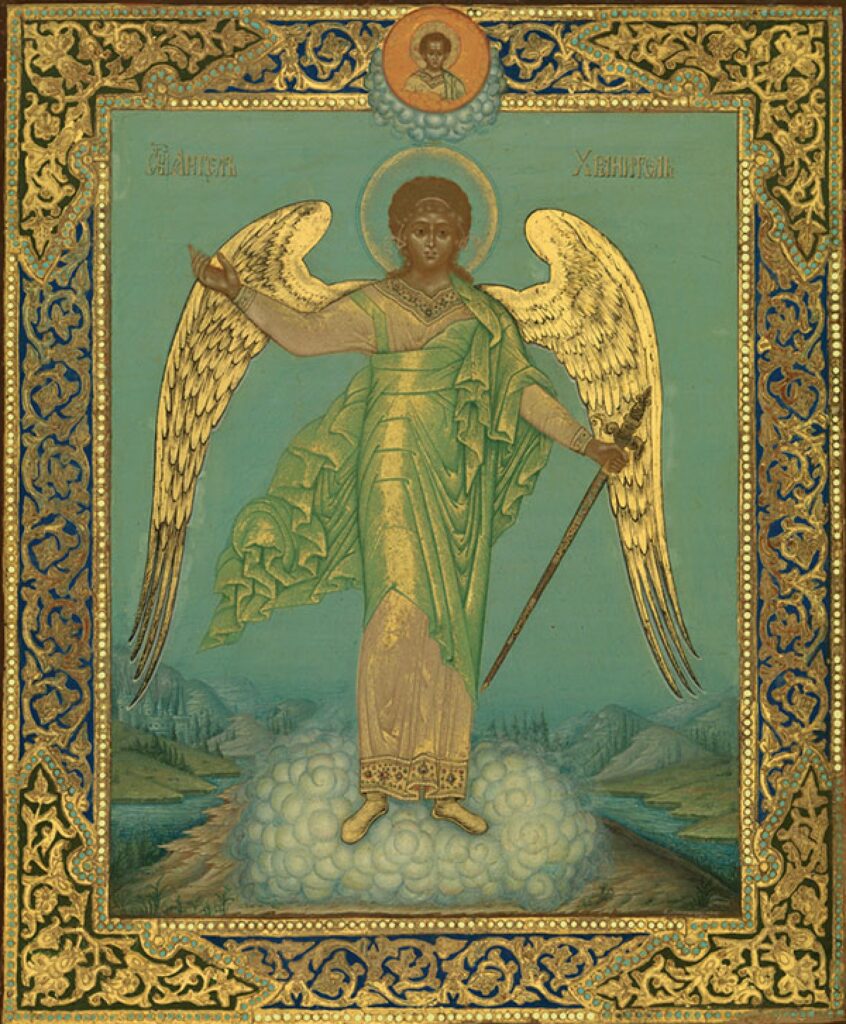
Guardian Angels in Early Christian Theology and Tradition
Hierarchical Structure of Angels: Pseudo-Dionysius’s Influence
Pseudo-Dionysius the Areopagite’s Celestial Hierarchy introduced a structured angelic order, dividing angels into nine choirs with specific roles. According to this hierarchy, guardian angels belong to the lowest choir, closest to humanity. This arrangement, widely adopted in both Eastern and Western traditions, provided a theological framework that positioned guardian angels as humble servants directly involved in human affairs.
Guardian Angels in Liturgical Tradition
As belief in guardian angels solidified, it became part of Christian liturgical practices. The Catholic Church instituted a feast day for guardian angels on October 2 (Memorial of the Holy Guardian Angels), which remains a day of honor for these protectors. This devotion reflects the belief that angels offer ongoing, personal care throughout one’s life.
Characteristics and Roles of Guardian Angels in Christian Belief
Guardian angels are traditionally viewed as protectors, guides, and intercessors. By the medieval period, their roles had become clearly defined.
Protectors of Body and Soul
Guardian angels are believed to shield individuals from physical and spiritual harm. Passages like Psalm 91:11-12 support this protective role, and theologians like Aquinas argued that angels use divine knowledge to guard humans from unseen dangers.
Guides on the Path of Virtue and Faith
Christian tradition holds that guardian angels guide people toward virtuous choices, encouraging moral decisions. They are seen as companions on the journey of faith, subtly influencing believers’ thoughts and actions toward a closer relationship with God.
Intercessors Between Humanity and God
Guardian angels also serve as intermediaries, carrying the prayers and concerns of individuals to God. This role emphasizes their role as compassionate figures who bridge the human-divine gap.
Depictions of Guardian Angels in Christian Art and Literature
Throughout history, Christian art and literature have depicted guardian angels in ways that emphasize their protective and nurturing qualities.
Iconography and Symbolism
Guardian angels are often shown with wings, symbolizing their divine origin, and are frequently depicted as gentle, nurturing figures protecting children. These images became especially popular in 19th and 20th-century religious art.
Medieval and Renaissance Art
Renaissance artists like Raphael and Fra Angelico portrayed angels as ethereal figures embodying protection and compassion. These artworks helped reinforce the idea of angels as personal guardians.

Literature and Folklore
Guardian angels appear in medieval saints’ biographies, such as the Golden Legend, and later in literature like Milton’s Paradise Lost. These portrayals reinforced the belief in angels as protectors who intervene in times of danger.
Comparisons with Similar Figures in Other Religions and Mythologies
Belief in protective supernatural beings is not unique to Christianity; it appears in various religious and cultural traditions worldwide.
Islam: Guardian Angels as Recorders and Protectors
In Islam, angels like the mu’aqqibat are assigned to protect believers. Also, each person also has two Kiraman Katibin who record their deeds, illustrating a belief in divine protection and accountability.
Hinduism and Buddhism: Protective Deities and Bodhisattvas
In Hinduism, guardian deities like ishtadevata protect individuals. Similarly, in Mahayana Buddhism, bodhisattvas like Avalokiteshvara offer compassion and guidance, fulfilling a similar role.
Ancient Greco-Roman Tradition: Daemons and Genii
In Greco-Roman culture, daemons and genii acted as personal protective spirits. These figures provided a model for later Christian guardian angels, highlighting the ancient roots of this belief.
Other Cultures: Protective Spirits and Ancestor Guardians
In indigenous and shamanic traditions, protective spirits take various forms, from animal totems to ancestral spirits. These figures fulfill a similar protective role, reflecting universal themes of guidance and care.
Psychological and Cultural Interpretations of Guardian Angels
Belief in guardian angels meets deep psychological needs for protection, guidance, and comfort. From a psychological perspective, guardian angels serve as coping mechanisms in times of crisis, offering emotional reassurance.
Projection of Positive Traits
Psychologists suggest that guardian angels may represent projections of individuals’ own virtues, such as resilience or compassion. This externalization allows people to connect with their best qualities.
Cultural Reflections of Social Values
Guardian angels embody social ideals of care and responsibility, reinforcing values like empathy and protection for the vulnerable.
Jungian Interpretation: Archetypes of the Collective Unconscious
According to Carl Jung, guardian angels reflect a universal archetype—an inner guide that embodies the human need for connection, purpose, and security.

Conclusion
The belief in guardian angels reflects a timeless human desire for protection, guidance, and reassurance. From ancient pre-Christian religions to modern times, guardian angels have symbolized the hope that we are not alone. In Christian thought, they serve as intermediaries, protectors, and guides, embodying a comforting promise that each individual’s life is valued.
Similar figures appear across various religions, from Zoroastrian fravashis to Islamic mu’aqqibat, suggesting a universal archetype. Psychological interpretations reinforce this, viewing guardian angels as symbols of resilience, inner strength, and moral clarity.
Ultimately, guardian angels persist because they meet essential human needs. Whether seen as literal beings, spiritual guides, or cultural symbols, they offer a sense of purpose and connection. As long as people seek comfort, meaning, and reassurance, guardian angels will remain a powerful part of the human story—a reminder that, even in our darkest moments, we can look to the light for strength and guidance.

